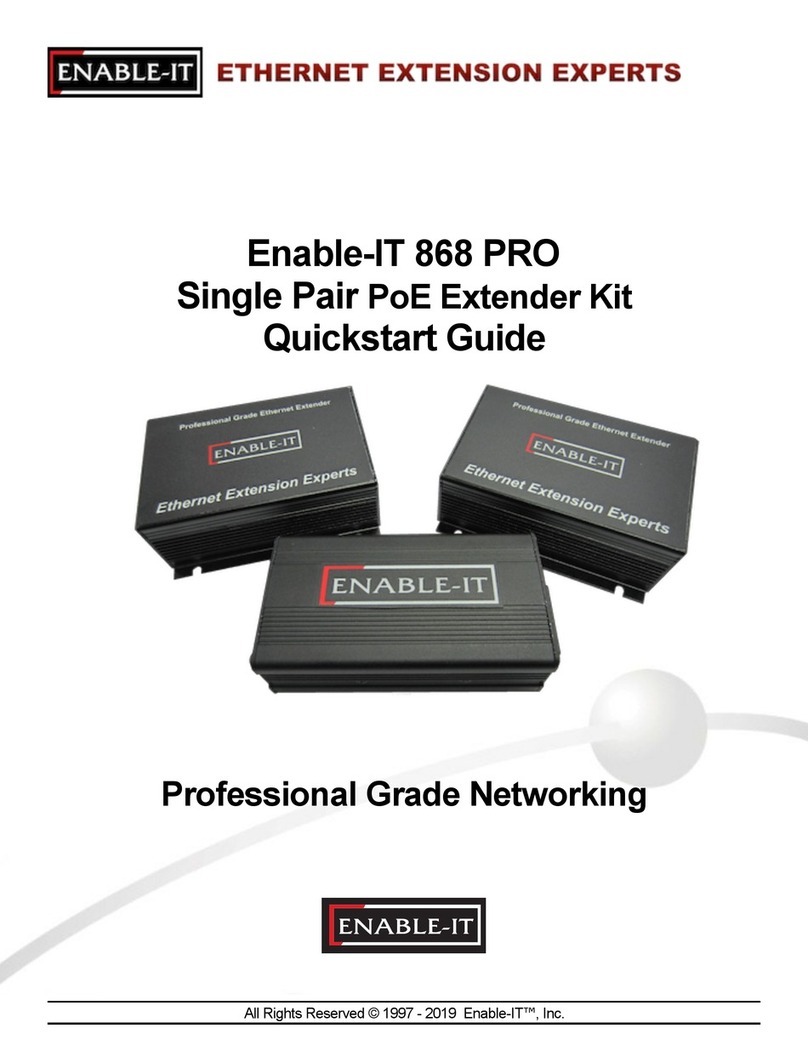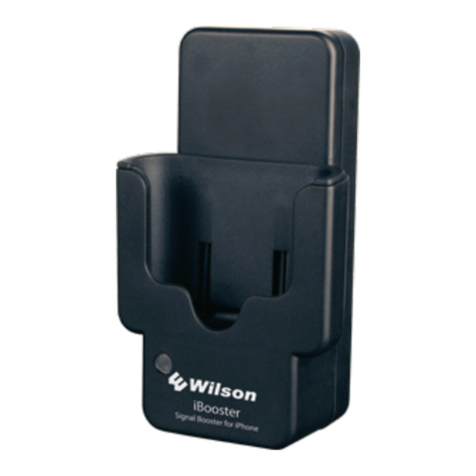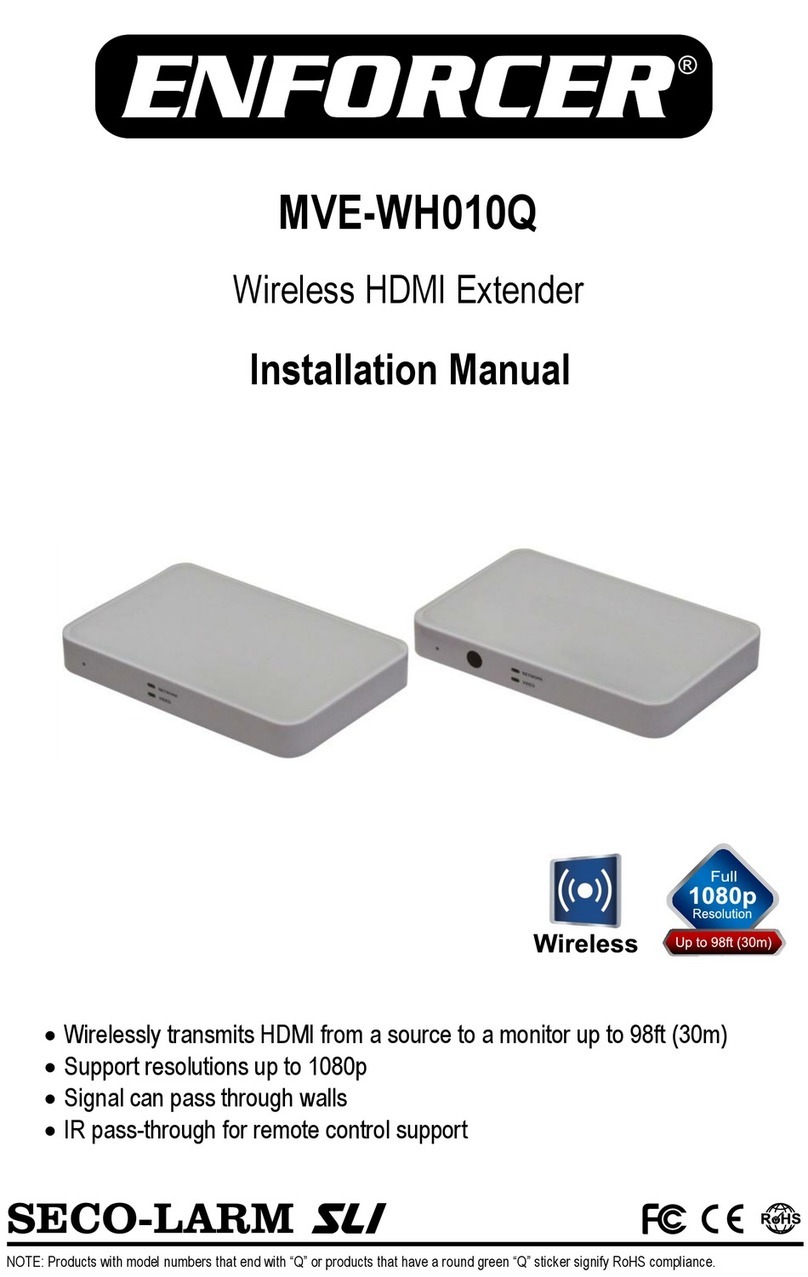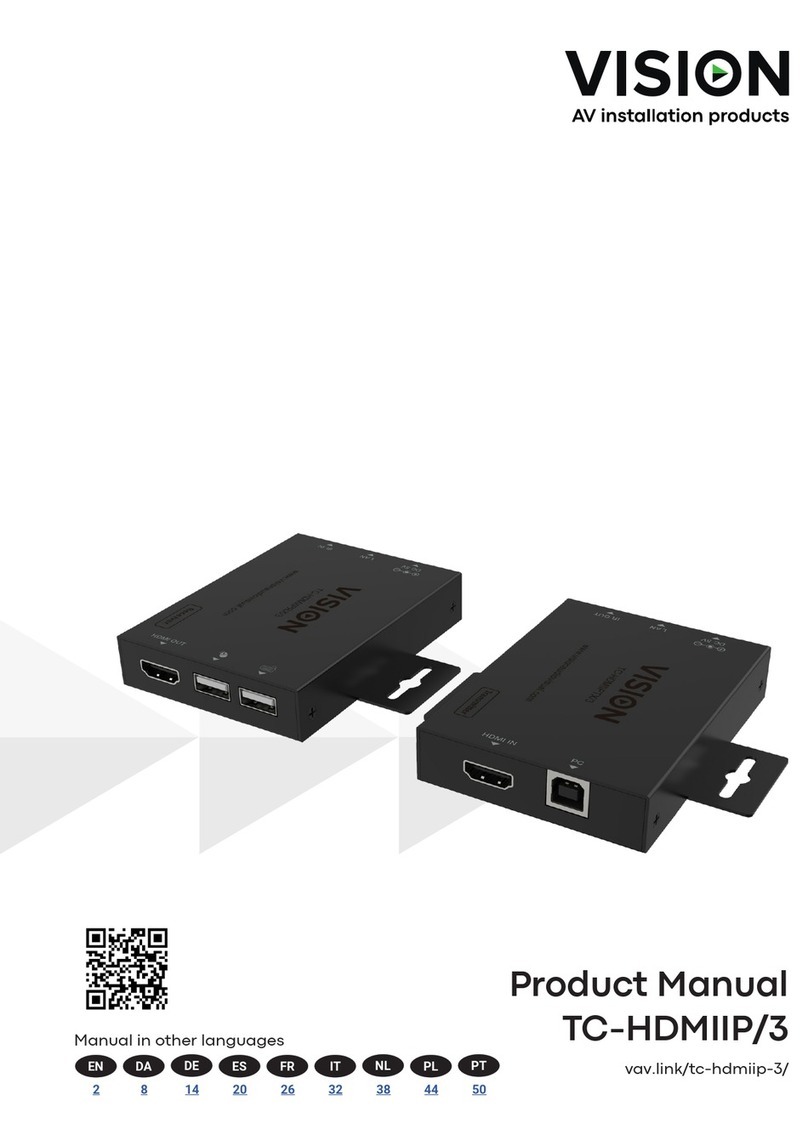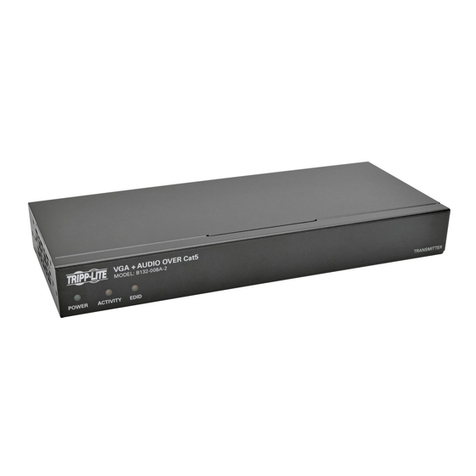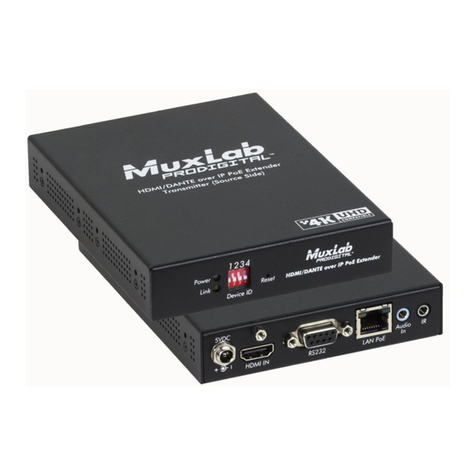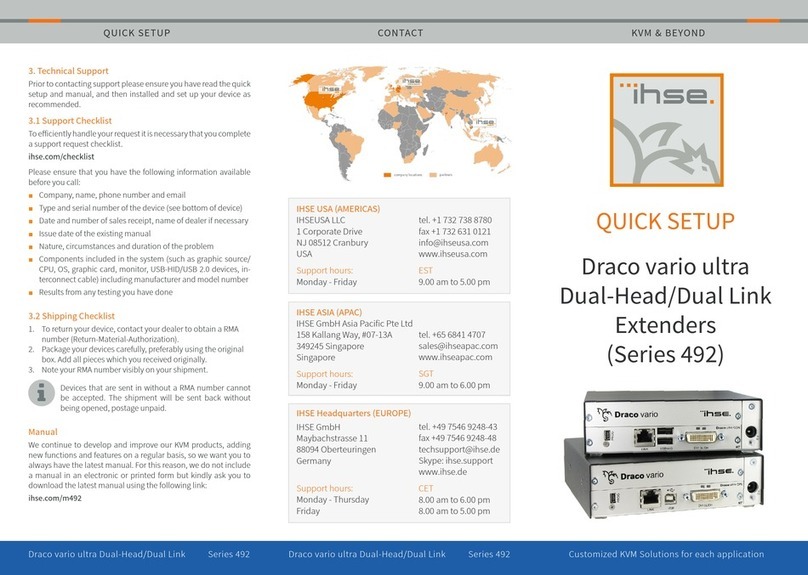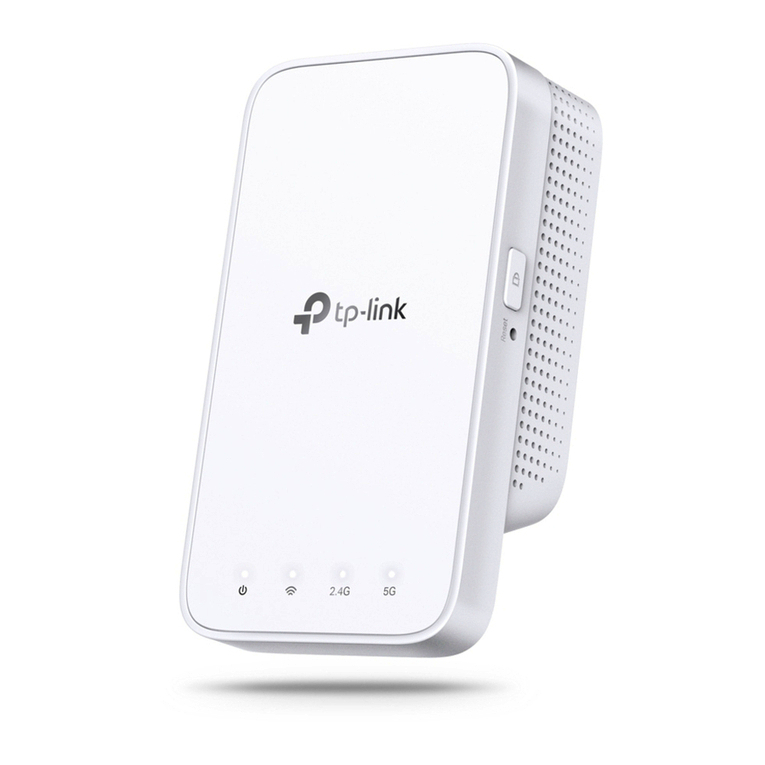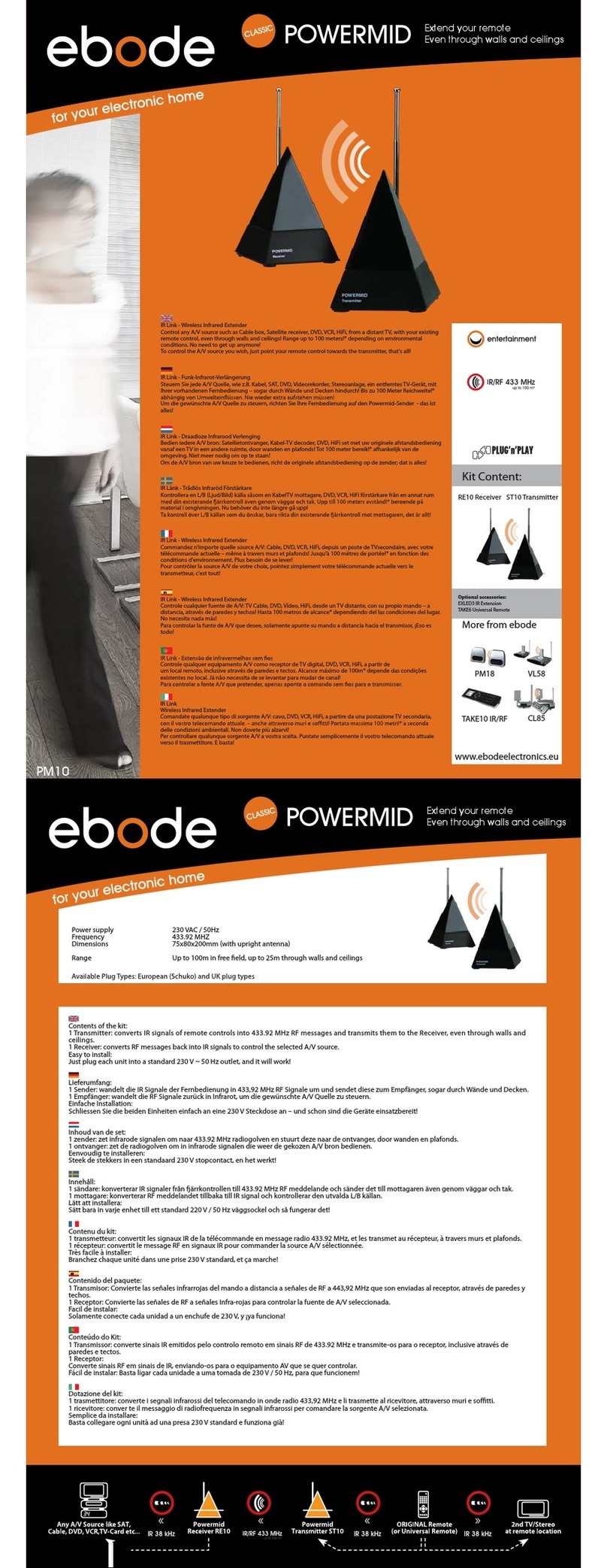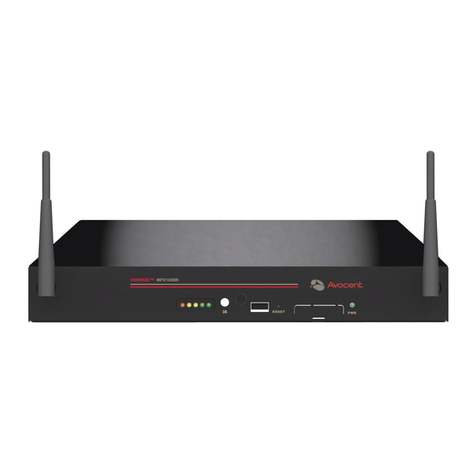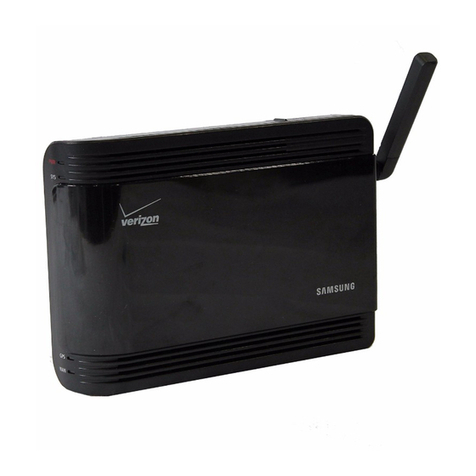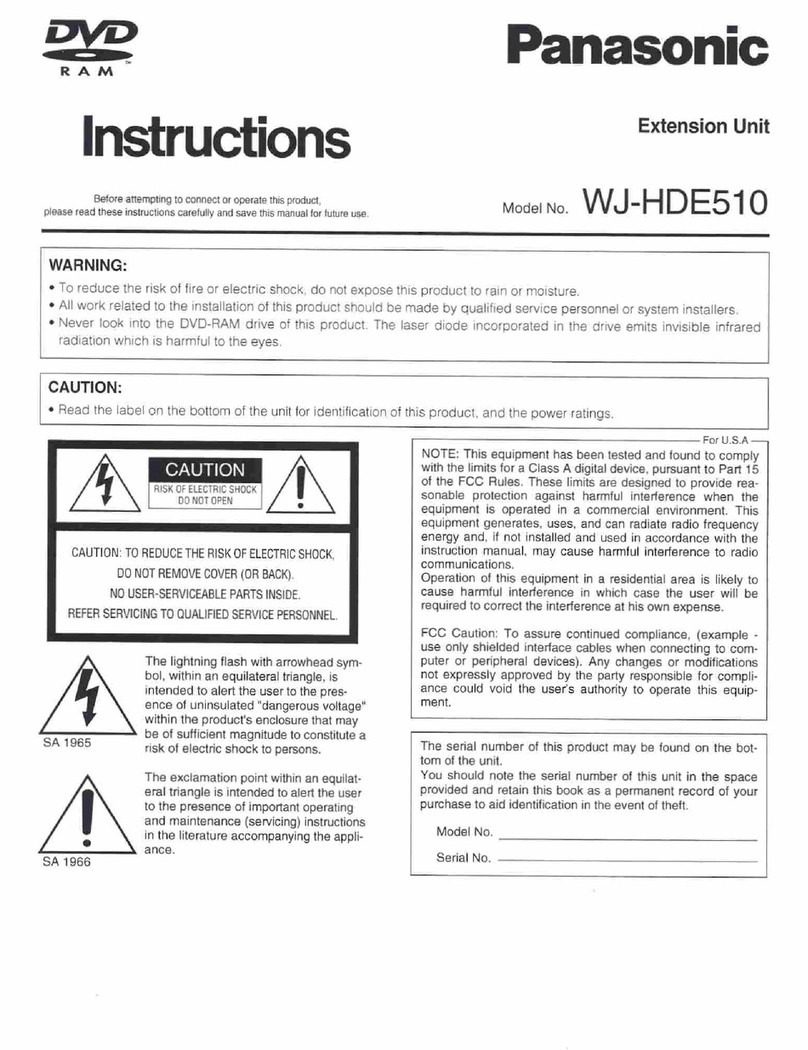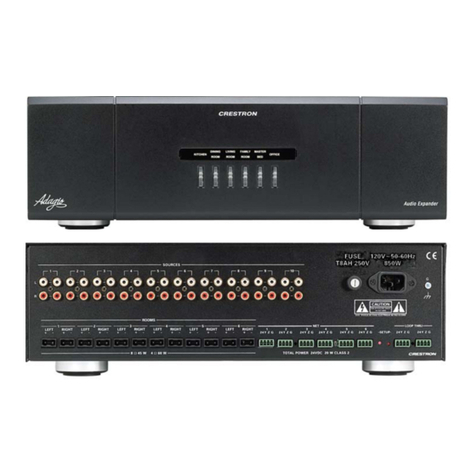Metrodata WCM1100 User manual

WCM1100 (E1/T1)
WCM3100 (E3/DS-3)
WCM-Serial
Managed Ethernet Extender
V7.17
Quick Start Guide
DATE: 21
st
August 2012
DOCUMENT NO: 76-02-082
REVISION: D
PREPARED BY: Ian Banbrook
Metrodata Ltd
Fortune House, Crabtree Office Village
Eversley Way, Egham Surrey, TW20 8RY, UK
Tel +44 1 784 744700
Fax: +44 1 784 744730

METRODATA LTD WCM1100 / WCM3100 / WCM-Serial
Quick Start Guide
76-02-082 Rev D
2 of 75
METRODATA LTD
No part of this publication may be reproduced, transmitted,
transcribed, stored in a retrieval system, or translated into any
language or computer language, in any form or by any means,
electronic, mechanical, magnetic, optical, chemical, manual or
otherwise, without the prior written permission of
Metrodata Ltd, Fortune House,
Crabtree Office Village, Eversley Way,
Egham, Surrey, TW20 8RY, United Kingdom
.
DISCLAIMER
Metrodata Ltd makes no representations or warranties with respect
to the contents hereof and specifically disclaims any implied
warranties or merchantability or fitness for any particular purpose.
Further, Metrodata Ltd reserves the right to revise this publication
and to make changes from time to time in the content hereof without
obligation of Metrodata Ltd to notify any person of such revision or
changes.
Copyright
2012 by Metrodata Ltd,
All Rights Reserved

METRODATA LTD WCM1100 / WCM3100 / WCM-Serial
Quick Start Guide
76-02-082 Rev D
3 of 75
Document Revision History
6
th
December 2010 A Document Created
29
th
June 2011 B Document updated for Software version
7.9 and merged with WCM3100 product
manual.
30
th
January 2012 C Upgraded for V7.14 application software,
and added support for WCM-Serial
product
21
st
August 2012 D Updated fro 7.17 Application software and
base label updates

METRODATA LTD WCM1100 / WCM3100 / WCM-Serial
Quick Start Guide
76-02-082 Rev D
4 of 75
TABLE OF CONTENTS
1INTRODUCTION..........................................................................................................8
2WCM APPLICATIONS...............................................................................................10
2.1
WCM Normal Mode ........................................................................................................................................10
2.2
WCM VLAN Trunk Mode..............................................................................................................................10
2.3
VLAN Trunk Mode..........................................................................................................................................11
2.4
S-Tag Mode.......................................................................................................................................................11
3QUICK START CONFIGURATION............................................................................12
3.1
Base Label.........................................................................................................................................................12
3.1.1
WCM1100 Base Label ..................................................................................................................................12
3.1.2
WCM3100 Base Label ..................................................................................................................................13
3.1.3
WCM-Serial Base Label................................................................................................................................13
3.2
Cold Start the Unit ...........................................................................................................................................14
3.2.1
Bit Switches...................................................................................................................................................14
3.2.1.1
Bitswitch 1, Boot Mode 0 ....................................................................................................................14
3.2.1.2
Bitswitch 2, Boot Mode 1 ....................................................................................................................14
3.2.1.3
Bitswitch 3, DHCP...............................................................................................................................14
3.2.1.4
Bitswitch 4, Framing............................................................................................................................15
3.2.1.5
Bitswitch 5, Timing Mode ...................................................................................................................15
3.2.1.6
Bitswitch 6, Interface Mode.................................................................................................................16
3.2.1.7
Bitswitch 7, SFP Mode ........................................................................................................................16
3.2.1.8
Bitswitch 8, Factory Default ................................................................................................................16
3.3
Access the WCM...............................................................................................................................................17
3.4
Logging onto WCM..........................................................................................................................................17
3.4.1
User Interface Navigation..............................................................................................................................18
3.5
Configure the WAN interface..........................................................................................................................19
3.5.1
WCM1100 E1 Configuration ........................................................................................................................19
3.5.2
WCM3100 E3 Configuration ........................................................................................................................20
3.5.3
WCM3100 DS-3 Configuration ....................................................................................................................20
3.5.4
WCM-Serial Configuration ...........................................................................................................................21
3.6
Set IP Address...................................................................................................................................................22
3.7
Set Default Route..............................................................................................................................................23
3.8
Save the Configuration.....................................................................................................................................24
3.9
Warm Start to activate the configuration ......................................................................................................25
4ADVANCED CONFIGURATION................................................................................26
4.1
System Configuration.......................................................................................................................................26

METRODATA LTD WCM1100 / WCM3100 / WCM-Serial
Quick Start Guide
76-02-082 Rev D
5 of 75
4.1.1
Setting the Time and Date .............................................................................................................................27
4.1.2
Setting the Node Name..................................................................................................................................28
4.1.3
Password........................................................................................................................................................29
4.1.3.1
Password Recovery..............................................................................................................................29
4.1.4
‘View’ User ...................................................................................................................................................29
4.1.5
Welcome Screen............................................................................................................................................30
4.1.6
Warm Start.....................................................................................................................................................32
4.1.7
Cold Start.......................................................................................................................................................32
4.2
Data Port Configuration..................................................................................................................................33
4.2.1
LAN Port .......................................................................................................................................................34
4.2.1.1
State......................................................................................................................................................35
4.2.1.2
Link Status ...........................................................................................................................................35
4.2.1.3
Auto Negotiation..................................................................................................................................35
4.2.1.4
Speed....................................................................................................................................................35
4.2.1.5
Duplex..................................................................................................................................................35
4.2.1.6
Negotiated............................................................................................................................................35
4.2.1.7
MDI/MDIX..........................................................................................................................................36
4.2.1.8
Counters...............................................................................................................................................36
4.2.1.9
OAM....................................................................................................................................................37
4.2.1.9.1
OAM Mode.....................................................................................................................................37
4.2.1.9.2
OAM Status.....................................................................................................................................38
4.2.1.10
Mgmt traffic.........................................................................................................................................38
4.2.1.11
VLAN ID .............................................................................................................................................39
4.2.1.12
QinQ S-TAG ID...................................................................................................................................39
4.2.1.13
default Priority .....................................................................................................................................39
4.2.2
SFP Port.........................................................................................................................................................40
4.2.2.1
SFP Type..............................................................................................................................................41
4.2.2.2
State......................................................................................................................................................41
4.2.2.3
Link State.............................................................................................................................................41
4.2.2.4
Speed....................................................................................................................................................41
4.2.2.5
Auto Negotiation..................................................................................................................................41
4.2.2.6
Negotiated............................................................................................................................................41
4.2.2.7
SFP Info ...............................................................................................................................................42
4.2.2.8
Counters...............................................................................................................................................42
4.2.2.9
OAM....................................................................................................................................................43
4.2.2.9.1
OAM Mode.....................................................................................................................................43
4.2.2.9.2
OAM Status.....................................................................................................................................44
4.2.2.10
mGmt Traffic .......................................................................................................................................44
4.2.2.11
VLAN ID .............................................................................................................................................45
4.2.2.12
QinQ S-TAG ID...................................................................................................................................45
4.2.2.13
default Priority .....................................................................................................................................45
4.2.3
WCM1100 WAN Port...................................................................................................................................46
4.2.3.1
State......................................................................................................................................................47
4.2.3.2
Interface ...............................................................................................................................................47
Timing ...........................................................................................................................................................47
4.2.3.3......................................................................................................................................................................47
4.2.3.4
RX Sensitivity......................................................................................................................................47
4.2.3.5
Framing................................................................................................................................................48
4.2.3.6
Allocation.............................................................................................................................................48
4.2.3.7
CRC-4 ..................................................................................................................................................49
4.2.3.8
sigNalling.............................................................................................................................................49
4.2.3.9
Counters...............................................................................................................................................49
4.2.3.10
OAM....................................................................................................................................................50
4.2.3.10.1
OAM Mode....................................................................................................................................50
4.2.3.10.2
OAM Status...................................................................................................................................51
mGmt Traffic.................................................................................................................................................51
4.2.3.11....................................................................................................................................................................51
4.2.3.12
VLAN ID .............................................................................................................................................52

METRODATA LTD WCM1100 / WCM3100 / WCM-Serial
Quick Start Guide
76-02-082 Rev D
6 of 75
4.2.3.13
QinQ S-TAG ID...................................................................................................................................52
4.2.3.14
default Priority .....................................................................................................................................52
4.2.4
WCM3100 WAN Port...................................................................................................................................53
4.2.4.1
State......................................................................................................................................................54
4.2.4.2
Interface ...............................................................................................................................................54
4.2.4.3
Timing..................................................................................................................................................54
4.2.4.4
TX Line Build Out (DS-3 mode Only) ................................................................................................54
4.2.4.5
Framing................................................................................................................................................55
4.2.4.6
Counters...............................................................................................................................................55
4.2.4.7
OAM....................................................................................................................................................56
4.2.4.7.1
OAM Mode.....................................................................................................................................56
4.2.4.7.2
OAM Status.....................................................................................................................................57
4.2.4.8
mGmt Traffic .......................................................................................................................................57
4.2.4.9
VLAN ID .............................................................................................................................................58
4.2.4.10
QinQ S-TAG ID...................................................................................................................................58
4.2.4.11
default Priority .....................................................................................................................................58
4.2.5
WCM-Serial WAN Port Configuration.........................................................................................................59
4.2.5.1
State......................................................................................................................................................60
4.2.5.2
Interface ...............................................................................................................................................60
4.2.5.3
Mode ....................................................................................................................................................61
4.2.5.4
Controls................................................................................................................................................61
4.2.5.5
State......................................................................................................................................................61
4.2.5.6
Counters...............................................................................................................................................62
4.2.5.7
OAM....................................................................................................................................................63
4.2.5.7.1
OAM Mode.....................................................................................................................................63
4.2.5.7.2
OAM Status.....................................................................................................................................64
4.2.5.8
mGmt Traffic .......................................................................................................................................64
4.2.5.9
VLAN ID .............................................................................................................................................65
4.2.5.10
QinQ S-TAG ID...................................................................................................................................65
4.2.5.11
default Priority .....................................................................................................................................65
4.2.6
Encapsulation.................................................................................................................................................66
4.2.6.1
Encapsulation.......................................................................................................................................66
4.2.6.1.1
HDLC..............................................................................................................................................66
4.2.6.1.1.1
HDLC FCS...............................................................................................................................66
4.2.6.1.1.2
Strip MAC FCS........................................................................................................................67
4.2.6.1.1.3
Payload Scrambler ...................................................................................................................67
4.2.6.1.2
X.86.................................................................................................................................................67
4.2.6.1.2.1
Strip MAC FCS........................................................................................................................67
4.2.6.1.2.2
Payload Scrambler ...................................................................................................................67
4.2.6.1.2.3
VCAT.......................................................................................................................................67
4.2.6.1.3
GFP .................................................................................................................................................68
4.2.6.1.3.1
Strip MAC FCS........................................................................................................................68
4.2.6.1.3.2
Payload Scrambler ...................................................................................................................68
4.2.6.1.3.3
VCAT.......................................................................................................................................68
4.2.6.2
Flow Control........................................................................................................................................68
4.2.6.3
Max Frame Size ...................................................................................................................................68
4.2.6.4
Priority Table .......................................................................................................................................69
4.2.6.4.1
802.1p Mode....................................................................................................................................69
4.2.6.4.2
IP DSCP Mode................................................................................................................................69
4.2.7
Traffic Isolation.............................................................................................................................................70
4.2.8
RSTP..............................................................................................................................................................70
4.3
SNMP Management.........................................................................................................................................71
4.3.1
Read/Write/Trap Community........................................................................................................................71
4.3.2
Contact Person...............................................................................................................................................71
4.3.3
Node Name....................................................................................................................................................72
4.3.4
Location.........................................................................................................................................................72
4.3.5
Managers .......................................................................................................................................................72

METRODATA LTD WCM1100 / WCM3100 / WCM-Serial
Quick Start Guide
76-02-082 Rev D
7 of 75
4.4
Saving the Configuration.................................................................................................................................73
5TFTP SOFTWARE UPDATE .....................................................................................74
5.1
TFTP Configuration.........................................................................................................................................74
5.1.1
Client Mode...................................................................................................................................................74
5.1.2
Server Mode ..................................................................................................................................................75

METRODATA LTD WCM1100 / WCM3100 / WCM-Serial
Quick Start Guide
76-02-082 Rev D
8 of 75
1 INTRODUCTION
This guide instructs the user in the use of the WCM1100 Managed Ethernet Extender over
E1, WCM3100 Managed Ethernet Extender over E3/DS-3 or WCM-Serial Managed
Ethernet Extender of Serial Connections This guide describes the functionality of
Software Release 7.14.
Throughout this document, the term WCM will be used to describe generic functions,
whilst WCM1100, WCM3100 or WCM-Serial will be used for product specific areas.
The Metrodata WCM allows for the extension of an Ethernet Service over a Wide Area
Network Connection. The WCM is a managed unit allowing for the effective demarcation
between LAN and WAN services. Management of the WCM is achieved using either
Telnet or SNMP via either the LAN or WAN ports.
In cases where management is not required, or undesired, the WCM can operate
standalone, with simple configuration options provided using bit switches located on the
underside of the unit.
The Metrodata WCM is a managed, multi port Ethernet Switch with a WAN uplink. The
WCM provides two 10/100/1000BaseT Auto Negotiating, Auto Switching Ports as well as a
single SFP port supporting either 1000Base-X or 100Base-FX SFP modules. The WCM
operates as a layer 2 bridge and as such may be used to extend a LAN segment over a
WAN link.
The WCM has an internal LAN switch offering full wire-speed switching between ports.
The WCM uses MAC address filtering to filter all local traffic and only forward traffic
destined for remote stations. Each of the WCM’s LAN ports support automatic cross-over
switching and will therefore connect directly to a Hub/Switch/Router or PC End Station.
The WCM has support for both tagged and untagged frames, with both VLAN C-Tag, and
Provider Bridge S-Tag (QinQ) modes supported.
The WCM supports either IP DSCP, or IEEE802.1p based traffic prioritisation with
outgoing traffic being queued in one of four priority queues.
The WCM supports link OAM, IEEE802.3ah and RSTP for loop prevention.
The WCM encapsulates the Ethernet traffic for transport across the WAN link. The WCM
supports HDLC in all cases, and for framed modes X.86 and GFP encapsulations are also
supported. Internal packet buffers enable the WCM to smooth out bursty traffic and
prevent packet loss as the higher layer protocols rate adapt to the WAN capacity.
The WCM1100 E1 port supports unframed, framed (with or without CRC-4 ) or fractional
(Nx64k) operating modes.
The WCM3100 supports unframed or framed operation, supporting E3 G.832 or DS-3 C-
Bit Framing modes.

METRODATA LTD WCM1100 / WCM3100 / WCM-Serial
Quick Start Guide
76-02-082 Rev D
9 of 75
The WCM-Serial supports unframed operation only, and normally operates as a serial DTE
interface for connection to a carrier NTU. An optional DCE mode, allows for back to back
operation.

METRODATA LTD WCM1100 / WCM3100 / WCM-Serial
Quick Start Guide
76-02-082 Rev D
10 of 75
2 WCM APPLICATIONS
2.1 WCM Normal Mode
In this application, the WCM is operating with Traffic Isolation Disabled. In this mode, the
WCM acts as a simple, layer 2, 5 port switch with packets being switched based on MAC
address alone. The WCM supports both local and remote switching, and forwarding over
the WAN trunk.
Management traffic is not isolated from the through data traffic, and both units may be
managed from any port.
2.2 WCM VLAN Trunk Mode
In this application, WCM-A is connected to a VLAN enabled LAN switch. The LAN switch
is configured as a VLAN trunk and all packets are tagged with VLAN Tags. WCM-A is
operating with VLAN support enabled but all ports defined as Trunks. A VLAN ID is
allocated to the Manager and thus management traffic is isolated from the user traffic and
the management VLAN, in this case 101, can be used to manage the WCM’s. WCM1100-
B is configured with VLAN support enabled but each port is configured as an access port
and isolated to a single VLAN.
Trunk ports expect packets to be tagged, whilst access ports expect untagged packets and
will add tag and priority to incoming packets.

METRODATA LTD WCM1100 / WCM3100 / WCM-Serial
Quick Start Guide
76-02-082 Rev D
11 of 75
2.3 VLAN Trunk Mode
In this mode, both WCM units have VLAN support enabled, and all ports are defined as
access ports VLAN 101 is used as the management VLAN and in unit WCM1100-A the
VLAN group 101 includes the LAN Port 1, the Manager and the PDH WAN port. At the
remote end, The SFP port is disabled to prevent customer access to the WCM manager.
2.4 S-Tag Mode
In this mode, the WCM adds a, port based, S-TAG to all incoming traffic. Where customer
traffic is already VLAN tagged, this leads to double tagging or ‘QinQ’ operation. The use
of the S-TAG enables the carrier to isolate customer traffic. Carrier management traffic is
carried with a separate S-Tag giving management access to both units, and on the
customer site the external management access is disabled.

METRODATA LTD WCM1100 / WCM3100 / WCM-Serial
Quick Start Guide
76-02-082 Rev D
12 of 75
3 QUICK START CONFIGURATION
The following guide gives a simple, quick start introduction to configuring the WCM for
Normal Mode operation as shown in section 2.1
3.1 Base Label
There is a label on the underside of each product which defines the cold start default
configuration of the unit.
3.1.1 WCM1100 Base Label

METRODATA LTD WCM1100 / WCM3100 / WCM-Serial
Quick Start Guide
76-02-082 Rev D
13 of 75
3.1.2 WCM3100 Base Label
3.1.3 WCM-Serial Base Label

METRODATA LTD WCM1100 / WCM3100 / WCM-Serial
Quick Start Guide
76-02-082 Rev D
14 of 75
3.2 Cold Start the Unit
When a WCM is shipped from the factory it will be in the default condition, however with
previously used equipment this may not be the case. To return the unit to the default state
will require a power cycle and configuration of the bit switches.
The underside of the unit has a set of accessible bit switches and a label, as shown below
for the two products:
Ensure all other bit switches are in the desired default positions.
To cold start the unit, first set bit switch 8 (Cold Start) to the OFF (Return to Default
Settings) position. Power up the WCM, wait for the Status LED to come on in any state,
and then power down. To return to normal mode, return bit switch 8 to the ON (Normal
Operation) position.
3.2.1 Bit Switches
The bit switches are also used to define the default settings and should be set accordingly
as defined below:
3.2.1.1 Bitswitch 1, Boot Mode 0
This bitswitch is used to determine whether the IP proxy management mode is enabled or
not. IP proxy mode utilises OAM to remotely manage a WCM device.
ON Proxy Mode Disabled
OFF Proxy Mode Enabled,
I
3.2.1.2 Bitswitch 2, Boot Mode 1
This bitswitch is ignored if Proxy Mode is disabled. When Proxy mode is enabled, this
mode determines whether the unit acts as Master/Server, or Slave/Client.
ON Proxy Mode, Server
OFF Proxy Mode, Client
3.2.1.3 Bitswitch 3, DHCP
This bitswitch enables DHCP for IP address allocation.
ON DHCP Disabled
OFF DHCP Enabled

METRODATA LTD WCM1100 / WCM3100 / WCM-Serial
Quick Start Guide
76-02-082 Rev D
15 of 75
3.2.1.4 Bitswitch 4, Framing
This bitswitch determines the operating mode of the PDH WAN interface.
ON E1 G.703, G.704 Framed with CRC-4 Enabled (WCM1100)
E3 G.703, G.832 Framed (WCM3100)
DS-3 G.703 C-Bit Framed (WCM3100)
OFF E1/E3/DS-3 G.703 Unframed
This bitswitch is unused on the WCM-Serial which does not offer framed modes.
3.2.1.5 Bitswitch 5, Timing Mode
This bitswitch determines the timing source for the PDH WAN interface
ON Internal Timing
OFF Loop Timing
Note, it is vital that one end of PDH WAN link is set to internal, as loop/loop will give an
unstable system.
This bitswitch is unused on the WCM-Serial, timing is defined by the auto sensing cable
type used.

METRODATA LTD WCM1100 / WCM3100 / WCM-Serial
Quick Start Guide
76-02-082 Rev D
16 of 75
3.2.1.6 Bitswitch 6, Interface Mode
This bitswitch selects between the two optional interface modes,
For WCM1100, E1 Interface
ON BNC, Unbalanced 75Ohm
OFF RJ45, Balanced 120Ohm
For WCM3100,
ON E3 G.703
OFF DS-3 G.703
This bitswitch is not used on the WCM-Serial as the interface mode is automatically
selected by the auto sensing cables.
3.2.1.7 Bitswitch 7, SFP Mode
This bitswitch is used to force the configuration of the SFP interface to match the SFP type
inserted.
ON 1000Base-X SFP
OFF 100Base-FX SFP
3.2.1.8 Bitswitch 8, Factory Default
This bitswitch will clear the stored configuration and return the unit to the default settings
as defined by the bit switches.
ON Normal Operation
OFF Factory Cold Start, load default settings
The main use of this switch it to ensure a unit can be accessed in the even that the
password has been lost.

METRODATA LTD WCM1100 / WCM3100 / WCM-Serial
Quick Start Guide
76-02-082 Rev D
17 of 75
3.3 Access the WCM
Initial access to the WCM is made using the Terminal Port on the rear panel of the unit.
The Terminal port defaults to 19200baud, 8bit, No Parity, 1 Stop Bit. The 9 Way D-Type
is configured as a DCE port with standard pinout as shown below:
Pin Direction
Signal
1 out DCD
2 out RXD*
3 In TXD*
4 In DTR
5 Signal Ground*
6 out DSR
7 In RTS
8 out CTS
9 no connect
Figure 3.3 Terminal Port Connector Pin Configuration
3.4 Logging onto WCM
The initial access to the WCM must use a terminal connected to the terminal port.
The WCM has a password protected, menu driven user interface. When a management
session is connected to the WCM, the welcome banner will be displayed as shown:
Metrodata WCM1100: Local connection to “”
Password (‘view’ to view only ) :
or
Metrodata WCM3100: Local connection to “”
Password (‘view’ to view only ) :
or
Metrodata WCM-Serial: Local connection to “”
Password (‘view’ to view only ) :

METRODATA LTD WCM1100 / WCM3100 / WCM-Serial
Quick Start Guide
76-02-082 Rev D
18 of 75
At the prompt, enter the password to gain access to the WCM. The default password is
the product name, ie “wcm1100”, “wcm3100” or “wcm-serial”. For security, the password
is obscured with an asterisk (*) being displayed for each character typed. An incorrect
password will lead to the welcome banner being redisplayed. A correct password will lead
onto the main set up menu as shown below:
Metrodata WCM "" Alarms: Major
MAIN SET-UP
Global status <display>
alarm eXtension <menu>
Data port set-up <menu>
V.24 set-up <menu>
Management <menu>
System <menu>
Update EEPROM
Testing <menu>
Performance data <menu>
First CAPITAL - select item
<escape> - exit menu
3.4.1 User Interface Navigation
The WCM user interface is a simple, menu based interface. Each selectable item may be
selected by typing the first capital of the option, e.g. for “Data port set-up” type <D>
1
or
<d>. Sometimes, where multiple items have the same starting letter the selection capital
will not be the first letter, e.g. “alarm eXtension” which is selected with <X> or <x>.
On the right side of the display is a list of what is below each item. This could be:
<menu> This indicates a sub-menu will be entered
<display> This indicates an information screen will be displayed. This may be
status or statistics.
Additional keys may be used to navigate the menu system:
<ESC> This will exit the current menu, or log out from the main set up menu.
<SPACE> This will toggle through a list of selectable options
<ENTER> This will select an item
1
Encapsulating an item within < > indicates a key press is required, for example <D>
means type D.

METRODATA LTD WCM1100 / WCM3100 / WCM-Serial
Quick Start Guide
76-02-082 Rev D
19 of 75
3.5 Configure the WAN interface
In order for two WCM units to communicate they must be connected using the PDH WAN
port. The WAN interface must be configured to match the network NTU configuration.
The WAN port is configured by selecting the Data Port Set-Up Menu,
Metrodata WCM "" Alarms: Major
DATA PORT SET-UP
lan1 <menu>
lan2 <menu>
SFP <menu>
WAN <menu>
Encapsulation <menu>
traffic Isolation <menu>
RSTP <menu>
First CAPITAL - select item
<escape> - exit menu
3.5.1 WCM1100 E1 Configuration
Ensure that the interface, timing and framing modes are correctly set to match the network
NTU settings.

METRODATA LTD WCM1100 / WCM3100 / WCM-Serial
Quick Start Guide
76-02-082 Rev D
20 of 75
3.5.2 WCM3100 E3 Configuration
For the E3 interface, the framing mode ( G.832 or Unframed ) must be configured as well
as the interface timing.
3.5.3 WCM3100 DS-3 Configuration
When DS-3 mode is selected, the framing mode ( C-Bit or Unframed ) must be set as well
as the interface timing. Additionally, the transmitter power must be configured by setting
the line build out to support either short ( <225ft ) or longer cable runs.
Other manuals for WCM1100
1
This manual suits for next models
5
Table of contents
Other Metrodata Extender manuals
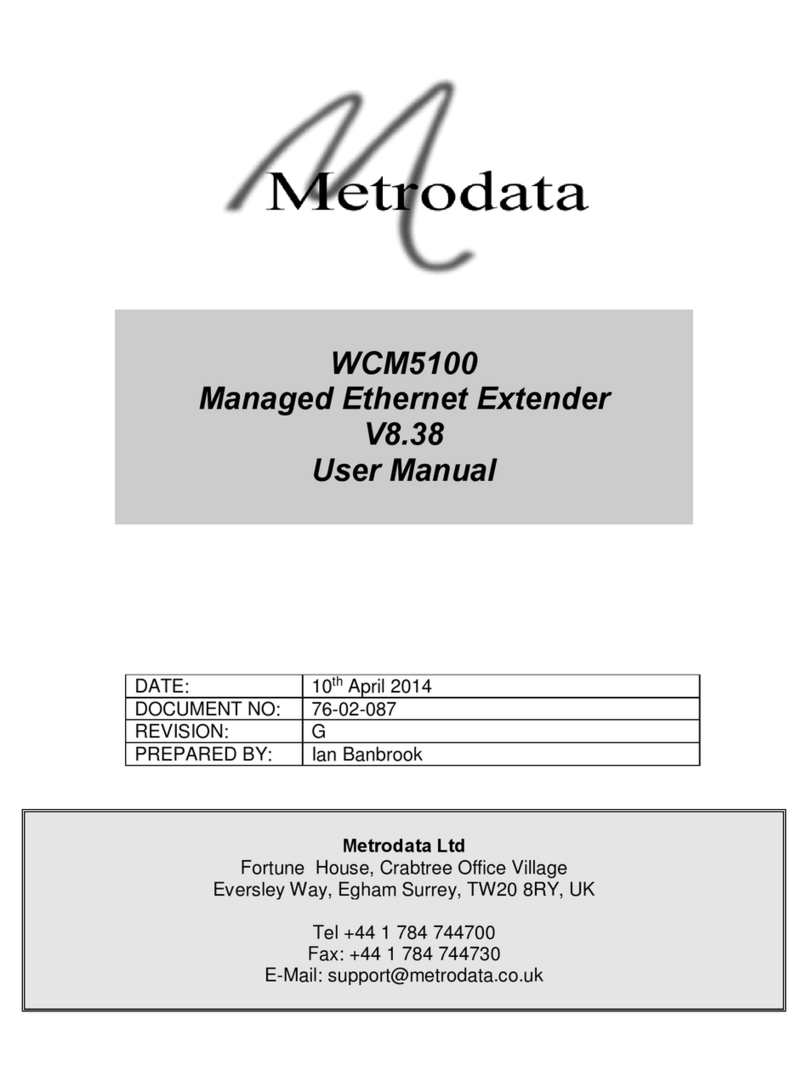
Metrodata
Metrodata WCM5100 User manual
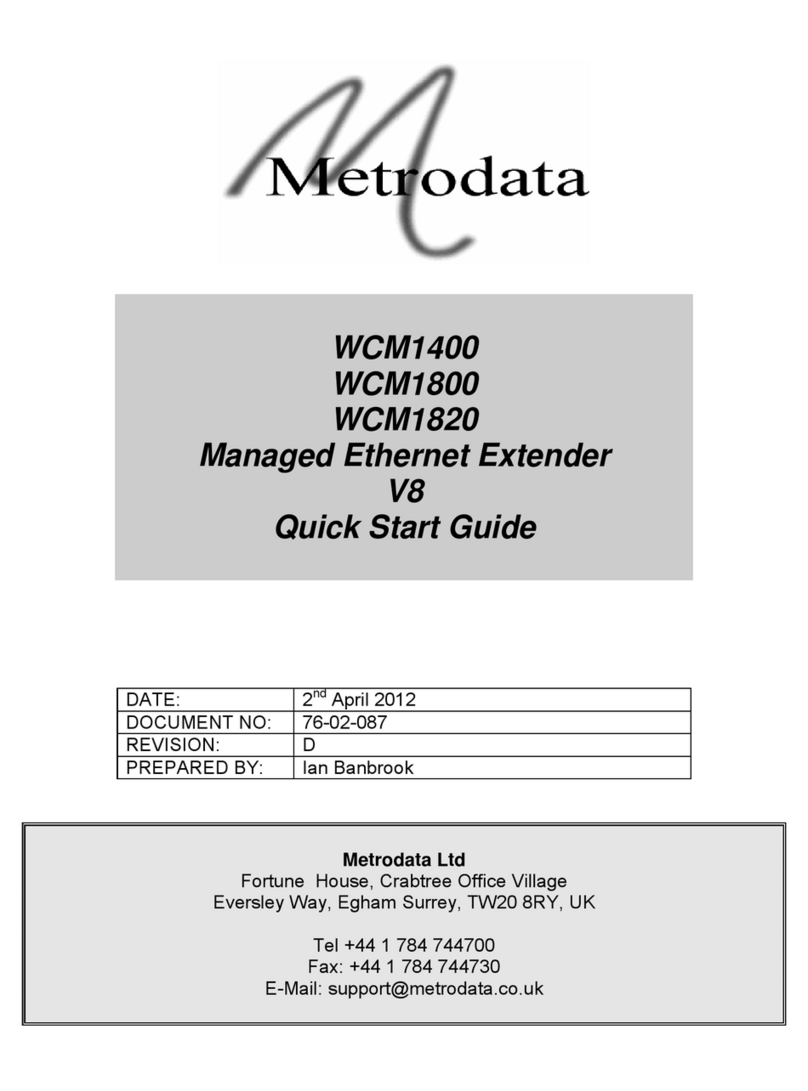
Metrodata
Metrodata WCM1400 BNC User manual

Metrodata
Metrodata WCM5100 User manual
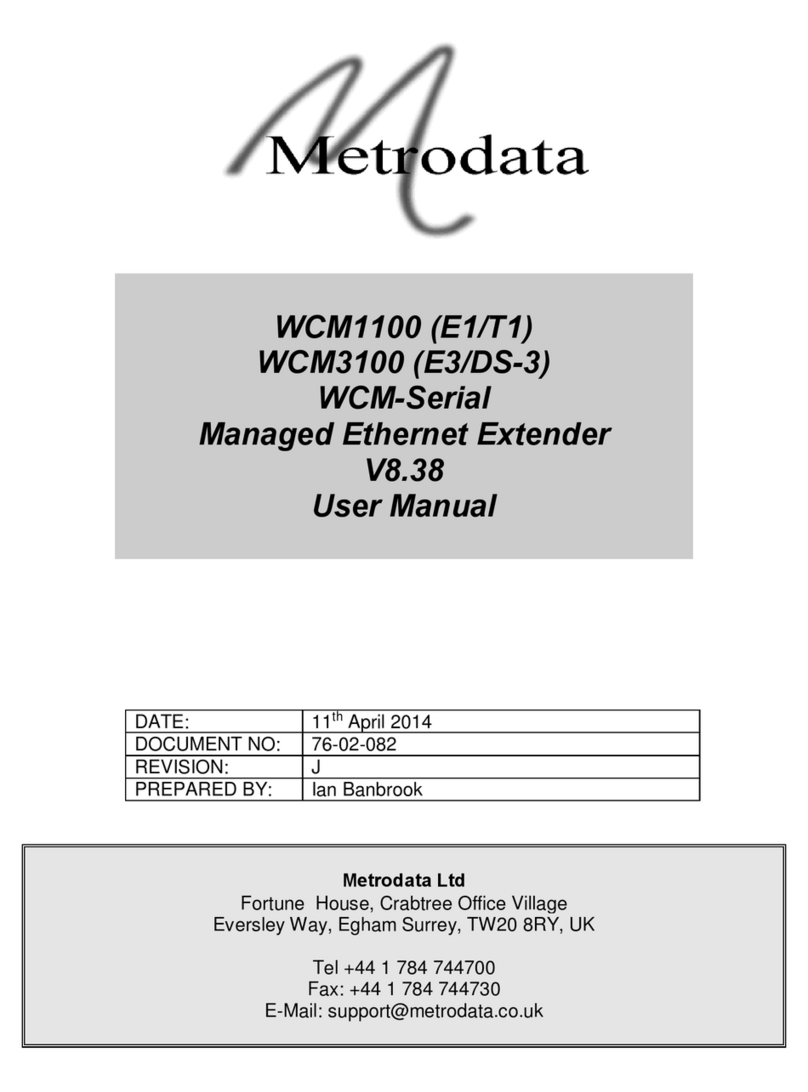
Metrodata
Metrodata WCM1100 User manual

Metrodata
Metrodata WCM5100 User manual
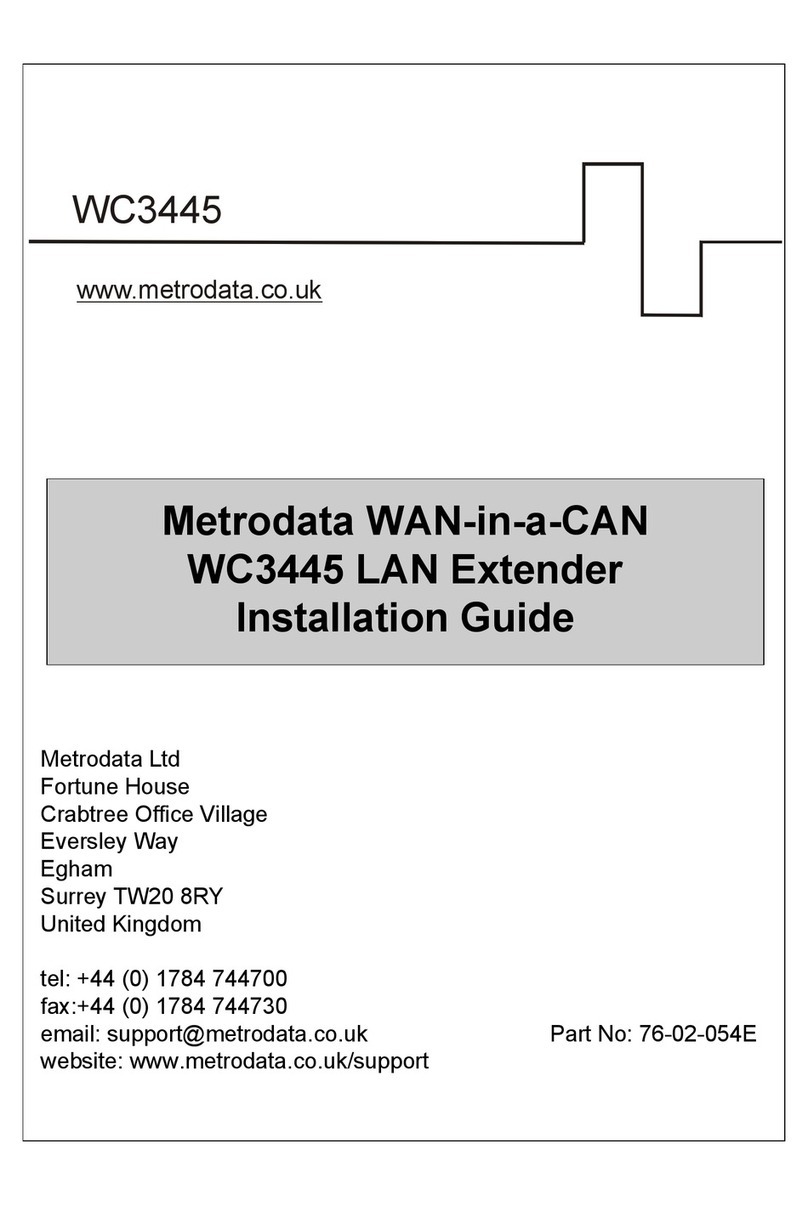
Metrodata
Metrodata WAN-in-a-CAN WC3445 User manual

Metrodata
Metrodata WCM5100 User manual
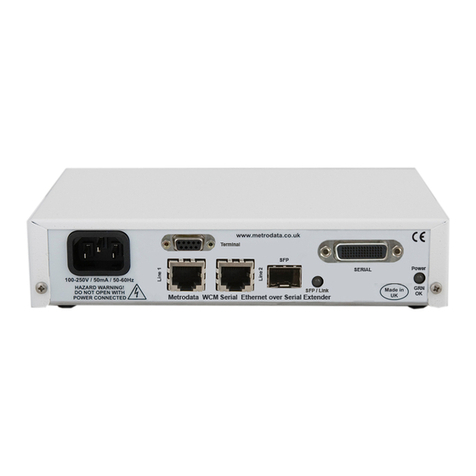
Metrodata
Metrodata MetroCONNECT WCM-Serial User manual
